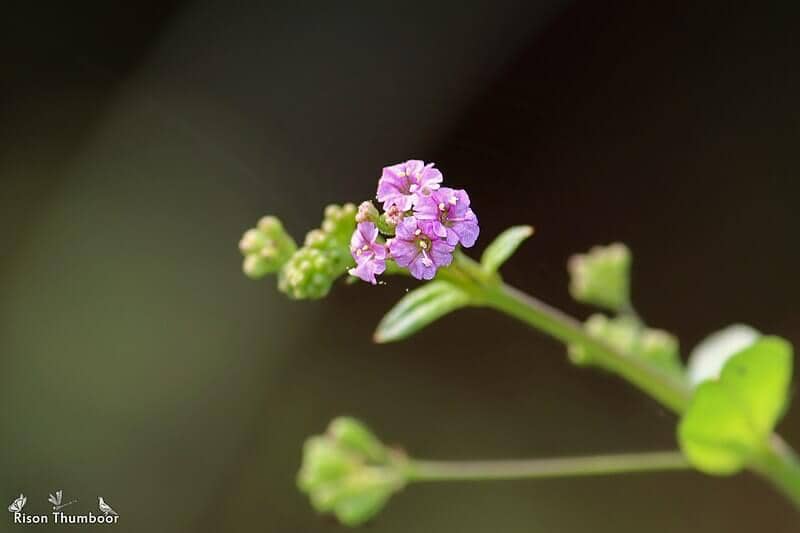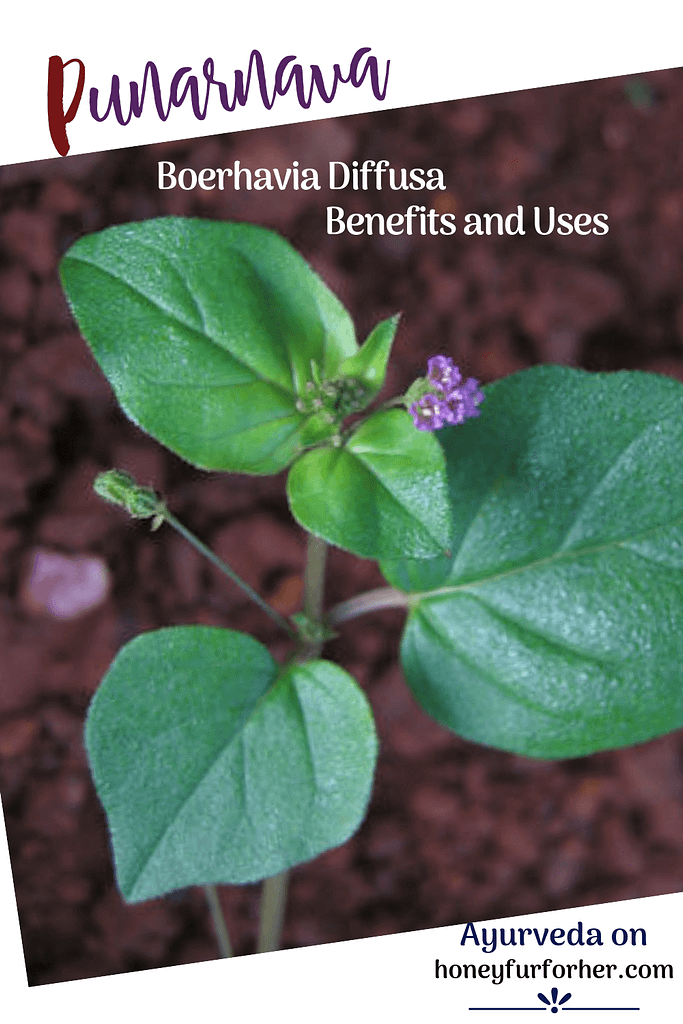
Imagine getting access to a plant that grows in the wild, requires no maintenance, and offers a multitude of benefits. Don’t believe us? Take a look at the Punarnava plant. Loosely translated, Punarnava means “new (punar) birth (nava)” and this plant stands up to its name due to its diverse health and nutritional benefits.
The Punarnava plant (Hindi name) – also known as Boerhavia Diffusa (English name) or Shothagni (Sanskrit name) – is a part of the “four o’ clock family” of flowering species. It is also referred to as red spiderling, spreading hogweed, or tar vine, and is widely dispersed throughout India, the Pacific, and Southern United States.
There are two types of Punarnava flowers – red and green. Its stout root-stock and spreading branches act as easy markers for identification. Also, note that all parts of the Punarnava plant are edible and useful in some manner or another.
There are some Ayurvedic medicines made using Punarnava as the main ingredient. Let’s explore them further:
- Punarnavarishta: This liquid decoction helps cure liver problems, kidney disorders, anaemia, and gastroenterological diseases. Additionally, it acts as a mild-analgesic, providing relief from body pains. It also provides instant relief from renal discomfort, pain from renal stones, and helps in the formation of urine.
- Punarnavadi Guggulu: This tablet form of medicine is used to treat gout, sciatica, lower backache, spondylosis, and other skeleto-muscular and joint disorders.
- Punarnavasavam: This ayurvedic liquid formulation is the star of “difficult-to-treat diseases” such as acid peptic disorders, abdominal lump, spleen and liver disorders, inflammatory diseases, etc.
- Punarnava Mandur: This iron-based tablet is used in the treatment of anaemia, piles, fever, haemorrhoids, dermatitis, etc. It is especially useful for children doubling up as a great source of iron.
- Amritaprasha Ghrita: This herbal ghee ayurvedic medicine is used as a preparatory procedure for panchkarma and is used for treating burning sensation, fever, cough, asthma, weakness, etc.
- Sukumaram Kashayam: This medicine is used for treating back pain and abdominal pain during menstruation, and for treating constipation.
- Narayan Oil: This ayurvedic oil is used for treating neuro-muscular and skeleto-muscular disorders like arthritis, neuralgia, etc.
Punarnava’s Ethnobotanical Uses
Punarnava is used to cure wide-ranging ailments such as insomnia, cataract, tuberculosis, asthma, eye disorders, kidney infections and disorders, fevers, colic, worms, rabies, alcoholism, heavy menstruation, clotting, fibroids and urinary tract infections. Additionally, the plant can be used as fodder for livestock and as a vegetable for culinary purposes.
Did you know that the Global Burden of Disease (GBD) study 2015 attributed Chronic Kidney Disease (CKD) to be the eighth leading cause of death? This is where the traditional Indian herb Punarnava is acting as a healthy ayurvedic alternative to treat kidney ailments as opposed to the limited and more harmful allopathic counterparts.
Interesting facts:
- The leaves of Punarnava are used as a green vegetable or “saag” in pulses and used in different parts of India. Consuming this helps strengthen the heart while preventing kidney stones and infections from reoccurring.
- This multi-purpose plant is being cultivated in the Krishna district under the “Zero Budget Natural Farming” policy.
- Nigerian folk medicine uses injections of the methanolic root extract taken from Punarnava to reduce the onset of seizures.
Punarnava Nutritional Information & Dosage
Nutritional Properties
- Anti-inflammatory
- Expectorant
- Anti-convulsant
- Analgesic
- Laxative
- Anti-microbial
- Diuretic
- Anti-spasmodic
- Astringent
- Cooling
- Anti-cancer
- Anti-hepatic
- Choleretic
- Purifying
Nutritional Information
100 gms Punarnava
=
162 milligram Sodium + 2.26% of Daily Recommended Protein + 44.8 mg Vitamin C + 142 mg Calcium + 1.61% of Daily Recommended Fat + 0.012 mg Iron
How to Make the Punarnava Panchang
Take the 5 key parts of the Punarnava herbal plant: plant, roots, leaves, flower, and bark – together known as the panchang – and dry it. Break it into smaller pieces and keep in an air-tight container. Then, take 4-7 gm of this churna (mixture) and boil in 400 gm of water. Reduce to a fourth of a quantity, and strain it before consuming.
Recommended Dosage
- 2,200-4,300mg for a person who weighs around 68 kg
- 2,900-5,800mg for a person who weighs 90 kg
- 3,600-7,200mg for a person who weighs 113 kg
- In the powdered form, it is safe to consume 2-5 teaspoons of Punarnava per day.
- Root powder recommended dosage is 3-6 gm; plant juice is 5-10 ml
Important: It is great to be proactive for your health but remember to consult your doctor before consuming this herb just as a precautionary measure.
Punarnava Holistic Benefits
Insomnia & restlessness
According to Acharya Balkrishna, grind the roots and mix it in water to make a “kadha.” Consume for blissful sleep.
Itching in the eyes/red eyes
For immediate relief in the eyes, Acharya Balkrishna recommends you grind the roots in a mortar and pestle into a paste and add Bhringaraj rasa (juice) to it. Alternatively, you can rub the roots in honey and apply if suffering from cataract, chronic conjunctivitis, and blepharitis.
Night blindness
Grind the Punarnava roots and add the juice of white onions to it. Use a clean cloth and strain this extract 2-3 times and use as eye drops in the eyes at night.
Mouth ulcers
Chewing the roots can help in mouth ulcers.
Warning: The taste is a little bitter so if you can spit out the after-taste if it becomes too difficult to swallow.
Heart problems
Punarnava’s leaves and bark can prevent congestive heart failure, anaemia and oedema. According to a study, around 55 per cent of Indian women suffer from anaemia. To tackle anaemia, consume amla, aloe vera and Punarnava.
Jaundice / Liver Issues
Combining Punarnava, shiv nag’s bark and bhumi amla can effectively treat Hepatitis B as per Acharya Balkrishna. Alternatively, you can also break the plant into small parts and tie it as a mala (necklace) using a string for relief. Conversely, you can consume Punarnava powder along with water to help reduce fat deposition in the liver which is also called the fatty liver disease.
Cough / Asthma / Recurring Fever
Take 4-5 gm Punarnava roots, 3-4 Tulsi leaves, and 1-2 peppercorns. Boil these and add a little mishri / jaggery for taste and consume. For small children, take the roots and mix with honey, and give them to the children. For people suffering from old fever, use Punarnava’s roots in the powdered form along with giloy plant and tulsi leaves in the form of a kadha and consume. This decoction causes the toxins to go out through the body via the urine.
Kidney
Punarnava has multiple benefits for the kidney – especially useful for people suffering from dialysis. According to two recent studies demonstrated on “World Kidney Day”, Punarnava-based drugs can help improve the functioning of the kidney while improving haemoglobin levels in the blood. Let’s look at an example: a woman suffering from kidney issues was given punarnava-based syrup for a month. The result: Her creatinine, haemoglobin, and urea levels in the blood rose to healthy levels!
Increasing appetite / indigestion / stomach disorders
You can use the Punarnava’s leaves and grind to a paste. Then add some mishri to it and make a sharbat. This herbal juice aids in increasing your appetite, strengthening your stomach muscles, and getting rid of intestinal worms.
Dysuria
For people suffering from low, painful urination (which can be extremely dangerous), take the Punarnava’s leaves and mix a little peppercorn to it. Consume this sharbat and see immediate relief.
Rheumatoid arthritis
The herb provides relief in the joints. Just grind the roots to a paste and apply locally. According to a study, Punarnava has been shown to effectively reduce the sensation of pain in mice by 47-50%
Skin issues
Punarnava helps reduce swelling and foul smell in skin problems.
Urinary disorders
The plant’s key chemical – flavonoid “Arbinofuranoside” – lowers serum uric acid, thereby proving useful for treating urogenital disorders.
Acne and obesity
Guggulu and Boerhavia diffusa can help you in reducing weight without losing out on electrolytes and potassium in the body. Follow a balanced eating lifestyle and witness the benefits firsthand.
PMS & Heavy menstruation/fibroids/blood clotting
Punarnava is also found useful in regulating kapha type PMS, the symptoms of which can be bloating, fatigue, crying, weepiness, lethargy and water retention. Taking 1/2 tsp of herb powder with honey gives relief in these symptoms. Punarnava is also helpful in menorrhoea and its symptoms like heavy bleeding.
Diabetes
Combine Guduchi (1 part), Shardunika (1 part), Kutki (1 part), and Punarnava (2 parts) and consume this herbal decoction (half teaspoon) two to three times a day with warm water to counter diabetes and related issues.
Epilepsy
Punarnava’s methanolic root extracts are known to block calcium channels, thereby helping treat leprosy.
Punarnava Side-Effects & Precautionary Measures
Typically, Punarnava is well tolerated in the human body and hence, is safe to consume in the raw form as a vegetable or in other forms mentioned above. However, there are some precautionary measures you should keep in mind:
- Pregnant women and children below 12 years of age should avoid consuming this herb due to high levels of sodium present in the plant.
- Lactating mothers should consult their doctor before consuming it.
- People suffering from diabetes should consume it under professional guidance as it contains sugar and a self-generated alcohol compound.
- Consume Punarnava post-meals only and not on an empty stomach as it may cause a burning sensation.
- Preferably, consume Punarnava powder with water only instead of milk.
- It can increase blood pressure so keep an eye on the blood sugar levels.
- It can cause burning sensations in the throat if consumed dry (without water).
- People having ethanol-related allergies should refrain from using this herb.
- Refrain from ingesting it before driving as it contains self-generated alcohol and so can cause drowsiness.
- Ensure you don’t overdose on this herb.
So what are you waiting for? Spring back to a healthy lifestyle filled with vitality with this rejuvenating Ayurvedic herb – one that’s readily available and relatively cheaper.
Did you find this post useful? Would you like to get back to it later? Save THIS PIN below to your Pinterest Natural Living or Herbs board!


You are doing a great job by writing about ayurvedic herbs for good health.
Thanks, Arupkumar for your kind words. I would love it if you subscribe to our blog!
Do you know where to find Punarnava(boerhavia diffusa ) plant in usa ?
Hi,
You are looking for the plant for your garden or you would like the punarnava medicine like powder etc.
Regards,
Swati